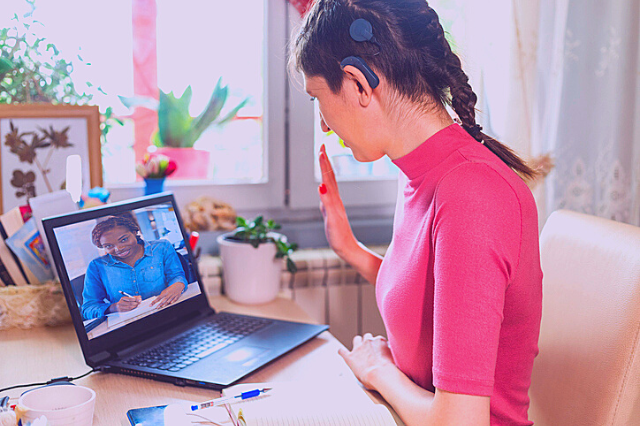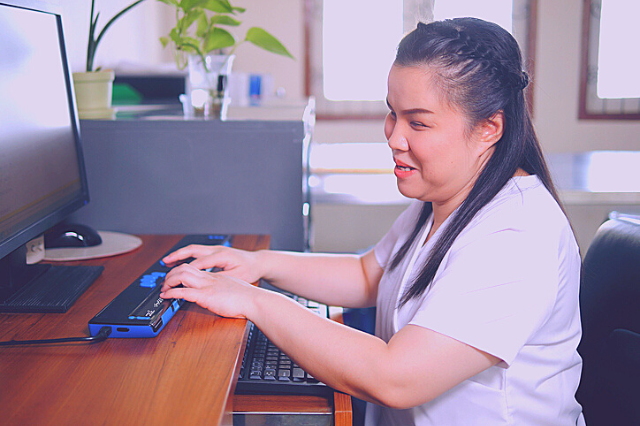Assistive technology and Remote Supports can provide support for people with intellectual and developmental disabilities (I/DD). Knowing the difference may help to determine which option would best meet your needs.
Let’s look at assistive technology devices and remote supports services, the difference between them, and their benefits.
What is Assistive Technology?

Assistive technology is used in home and community-based services (HCBS), and person-centered planning to give people with I/DD more freedom.
Most of us use devices daily, such as cell phones, smartwatches, or AI devices, such as Alexa. People with disabilities also use devices, just like we do. However, they may use other assistive devices that are made just for them.
How is Assistive Technology Used?
People with I/DD use assistive technology to expand their capacity to function in their daily lives. Imagine being able to see clearly, write, hear, remember, or do anything that expands your abilities with just a little bit of support. That’s the power of assistive technology, which allows people with disabilities to lead more independent and fulfilling lives.
How Assistive Technology Enhances Inclusiveness?
Assistive technology is a game-changer for inclusion because it lets people engage and participate more fully in society. For example, there are tools that help people who don’t speak to talk to the people around them. This breaks down barriers and makes it easier for people to connect.
Assistive Technology Examples
Some assistive technology examples:
- Stove Sensor: A device that uses motion to detect an unattended stove and shut it off.
- Seizure Wrist Band: a device worn on the wrist that detects seizure-type movements.
- Door Sensor: A device that detects whenever a door is opened.
Limitations of Assistive Technology
According to a study by the NIH National Library of Medicine, the most common barrier to people with IDD receiving help through Assistive Technology was simply a lack of knowledge. That means awareness could improve many people’s lives if more understanding of the benefits of AT were discussed by a disability case manager when planning a person’s care plan.
Other limitation exists, and one of them is not always being able to alert a support network in case of an emergency. Plus, those pesky false alarms can drive caregivers up the wall, and in the worst case, they may even start to ignore them altogether.
That’s why it’s important to remember that while technology is great, it can’t replace the human touch. There are nuances that only a person can pick up on, like if someone has simply nodded off instead of being in danger. So let’s keep finding ways to combine the power of technology with the empathy and intuition of human-to-human connections.
What are Remote Supports?

Remote Supports uses a team of support staff and assistive technology to build a layered approach to service. It’s a person-centered planning process with outcome goals to help each person reach their goals. It’s all about giving people choice and making sure they have the tools they need to live happy lives.
Remote Supports’ focus is never on the technology being used. Instead, the focus is on the person’s desires and needs for support.
A study conducted by the NIH National Library of Medicine found that individuals with I/DD reported feeling more independent when using remote support services.
Remote Supports staff is trained to each state’s guidelines. Staff supports each person in building skills to lead more self-determined lives. They also provide a much-needed break for support already in place, like parents or guardians.
The shortage of DSP workers is an ongoing issue for people with disabilities. Over 40% of DSP workers left the industry in 2019. After this shortage, there was a global crisis in the form of a pandemic, which closed more doors for people with I/DD. Assistive technology and Remote Supports services offer a game-changing solution. It means individuals can receive the support they need with greater independence and control over their lives.
How are Remote Supports Services Used?
Some people with disabilities understand they need support. However, they may want that support in the least restrictive and invasive way possible. Remote Supports services tick these boxes.
With the use of assistive technology and trained off-site staff people can get the help that fits their needs and wants. With tools that expand their capabilities and alerts that keep them safe, individuals have greater autonomy to live life on their own terms while still receiving the support they need.
Examples of Remote Supports Services
If the off-site staff receives an alert that someone may be experiencing a seizure, they will try to get in touch with that person to see what’s going on. Based on what is happening, Remote Supports staff follows the plan of action that’s already laid out.
In addition, because health data is being collected, the data may be able to pinpoint a pattern of activity that may trigger a seizure. This information can improve the support plan to minimize activities that may cause the onset of a seizure.
Limitations of Remote Supports Services
While Remote Supports is very comprehensive, there are some limitations to keep in mind. Support is provided to an individual via video/audio, and not hands-on. In the event of an emergency, Remote Supports handles this with a plan of action that is pre-written into the person’s support plan. That way, the person with I/DD is safer.
With Remote Supports, someone is there 24/7 to receive any alerts. In addition, someone is always there to connect and check in if necessary.
The Benefits of Using Assistive Technology or Remote Supports Services
There are many benefits of using assistive technology and remote supports services to support people with disabilities.
With the DSP shortage, many people with disabilities don’t have access to in-home staff. Additionally, some people prefer not to have strangers in their space.
Assistive technology involves the individual’s consistent use of the device. It may also include connections to natural supports, such as caregivers.
Remote Supports adds human interaction along with assistive technology for greater support. It can serve as a much-needed service that allows loved ones of people with disabilities to have some peace of mind and a life of their own.
Where to Get Assistive Technology or Remote Supports
The best way to get assistive technology or Remote Supports services, which includes assistive technology is by qualifying for disability benefits through the state. The state provides a waiver that will pay for support services to every eligible person. This includes the selection of the service and who provides the service.
You can learn more about how to get disability benefits here.




